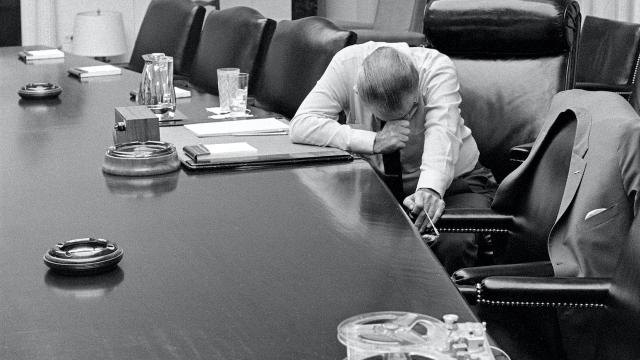There’s a photo of President Lyndon B. Johnson currently circulating on Twitter that purports to show LBJ overcome with emotion at the thought of so many deaths during the Vietnam War. It’s an iconic image, but the photo is being taken out of context. In reality, Johnson probably isn’t mourning the deaths of 40,000 U.S. soldiers in the summer of 1968. He’s positioning his head so that he can understand what’s being said on an audiotape recording playing from the speaker in front of him.
The photo was taken by presidential photographer Jack E. Kightlinger in the Cabinet Room of the White House on July 31, 1968 and is available at the U.S. National Archives and LBJ Presidential Library websites. The image has been used in countless documentaries about the Vietnam War and supposedly shows how much Johnson struggled emotionally with the human toll of the war.
According to folks on Twitter, it’s also a great example of a president showing real emotion during a time of crisis, unlike President Donald Trump, who has so far overseen the deaths of nearly 41,000 Americans during the coronavirus pandemic and continues to act like a petulant toddler.
“This is a photo of President Johnson in 1968 about the time American deaths in Vietnam reached 40,000, the number of Americans dead so far from COVID-19,” Twitter user Glenn Smith wrote in a tweet that’s gone viral.
And while President Trump is truly a despicable human being who has prioritised his own political survival over human lives, President Johnson wasn’t crying over thousands of dead American soldiers in the photo.
Johnson is actually listening to an audio tape that was created by Captain Charles “Chuck” Robb, his son-in-law. That detail would allow the casual viewer to assume that LBJ was distressed to hear the recording, but it seems that so many of the documentary filmmakers who use this image haven’t bothered to look at the other photos taken during that same time in the White House.
The photo in question is archived under contact sheet B1274, which is available by request from the Lyndon B. Johnson Presidential Library in Austin, Texas. If you look at the photo taken just before LBJ’s “anguished” photo in the camera roll, you can see the president leaning in toward the speaker in front of him.
There’s also the President’s daily diary for that day, July 31, 1968, which makes note of the fact that it was difficult to hear the tape. They tried to “put it on a new tape,” though it’s not clear what that means. But whatever adjustments were made “it was still pretty difficult to hear it,” according to the notes.
There’s another contact sheet of film that was taken during the same meeting that makes it even more clear. In contact sheet B1273 we can see President Johnson from another angle, with the speaker in front of him clearly drawing his entire focus.
The photos taken just after the famous shot show President Johnson still hunched over, but perhaps conferring with his unnamed staffer to his left.
And the two photos directly after that give us a better look at the tape player that was playing Captain Robb’s message, presumably into the speaker in front of Johnson.
More photos from the other side of the table give us a better look at that speaker in front of Johnson, annotated for emphasis.
All of that being said, it’s still possible President Johnson felt some emotion while listening to a tape from the battlefield. It was something to be taken seriously, as there was clearly sound of gunfire. But Johnson also joked during that period, noting that he very infrequently used the Cabinet Room of the White House and had invited his staff in to “make believe like I was President.”
Johnson also noted that the audiotape from Captain Robb wasn’t meant for the president, but was instead a message sent home to Robb’s wife, Johnson’s own daughter, Lynda Byrd Johnson Robb.
None of this is evidence that Johnson wasn’t in a somber mood while these photos were taken, but if you know the history of Johnson’s involvement in Vietnam, you shouldn’t go so easy on him or describe this famous photo as proof of “empathy” on LBJ’s part.
Historian of science, tech, and American politics Peter A. Shulman points out that Johnson’s escalation of the Vietnam War was an incredibly cynical endeavour that killed roughly 3 million Vietnamese citizens. Johnson knew that the war couldn’t be won, but constantly lied for the purposes of domestic politics.
I don’t even know where to begin on this one. pic.twitter.com/PbF8WgDGTa
— Peter A. Shulman ???? (@pashulman) April 20, 2020
“Johnson was one of the most abusive & manipulative of men to ever hold the presidency, & had more empathy than probably the solitary figure of Donald Trump,” Shulman concludes.
The U.S. is currently struggling with a pandemic that has forced millions out of work and given people some heartbreaking life-and-death choices. Trump has body count that should never be forgiven, no matter how hard he tries to spin his way out of it.
The U.S. currently has over 761,000 identified cases of covid-19 and at least 40,905 deaths, according to the latest figures from Johns Hopkins“more than any other country by far. And Trump has refused to accept responsibility for any of it. Trump is, objectively speaking, a bad president. But we don’t need to whitewash history to show that.
Johnson was no angel, and photos can lie. Or, in this case, photos can bend the truth just enough to make it look like you’re breaking down emotionally when really you just can’t hear an audio recording made with shoddy 1960s tech.
